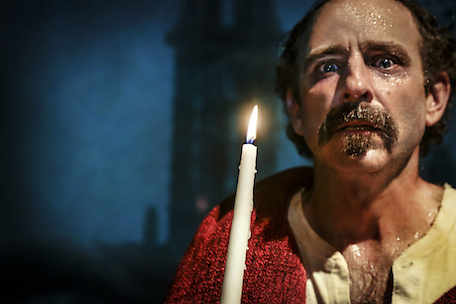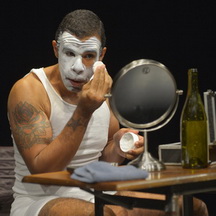
Central Works opened its world premiere of Robert Louis Stevenson: Jekyll and Hyde this past weekend. It’s the third in writer and Central Works Co-Director Gary Graves’ dramatic trilogy delving into the gothic mind. And it’s forcefully and compelling delivered with actors Brian Herndon as Robert Louis Stevenson and Danielle Levin as his wife Fanny. Jan Zvaifler did the meticulous stage direction.
Stevenson’s Strange Case of Dr. Jekyll and Mr. Hyde was written in 1886, while the writer was convalescing in Bournemouth, a sea town on the southern coast of England. A year later it would appear on the Boston stage, and then travel to the UK where it ran for some 20 years. Since then, dozens of theatrical versions and readings have appeared, with over 120 film adaptations alone. All a testament to the power of Stevenson’s idea and his writing.
What makes the Central Works’ version interesting is that it looks at how the novella was written. Presenting a plausible reconstruction of the inspiration behind the book, the play also examines the relationship between Stevenson and his wife. It has been asserted by some historians that the American-born and independently minded Fanny had far too much influence over the Scottish writer, who was 10 years her junior. That suspected influence, though likely overestimated and ignoring the necessity the isolation of writers to have critical readers, is part of the mythology of the Strange Case.
When the play opens, Herndon is lying on a couch, scribbling at his portable writing desk. He is in a nightgown, swaddled in blankets. In goggles and black leather respirator, he looks like an odd cross between a WWI aviator and an S&M practitioner. A relevant metaphor for the unfolding story of Jekyll and Hyde and for the creative process itself.
The ill creature on the couch throws off his mask and goggles, coughs and heads for the bottle of wine on the desk behind him. He pours a white powder into the red wine and drinks it down. Here is Robert Louis Stevenson, a popular writer who has suffered from an inherited “weakness of the chest” and whose life is plagued by illness, relapses and a perpetual search for a climate that would be more favorable to his frail constitution than the chilly climes of his native Scotland.
Not long after, a woman enters. It is Fanny. She chastises him for taking off mask and goggles. And the conversation moves on to more domestic quarrels over money, family and work. It slides then into the central discussion: money or art and truth. Fanny wants Louis to write entertainments that please and pay. Louis wants to write art and truth: “something sublime.” Fanny poses the question, “Does every piece of art have to be truth?” They wrangle.
Finally, the play moves into the novella itself. And here the action becomes its most compelling. Louis must convince Fanny that his story has merit, and in the process he enacts the story itself, reciting long passages from the original. This story within a story is an intelligent device. It allows us access to Stevenson’s thrilling prose. And much of the recitation is a theatrical tour de force. Herndon goes all out, changing accents from Scottish to English received pronunciation as he as moves from Stevenson, the writer, to Jekyll, the respected doctor.
In the course of the discussion, it’s revealed that what is fuelling Stevenson’s imagination is a series of nightmares. And what’s fuelling his artistic energy is the cocaine that the doctor has given him to treat his illness. He will, in fact, write the 100-page novella in under a week. Is it the drugs, or is it that he has wrestled with this idea of a pleasure-seeker’s “turn toward the monstrous” through various other stories and sketches? Is the question of “evil” woven into Stevenson’s possible addiction, or was it buried deep in his Calvinist upbringing?
Hard to know. And until Dr. Who appears with his TARDIS, we are unlikely to know. But in the meantime, go see the play. Ponder its questions.
Oh, and read the book.
– Jaime Robles
Central Works’ production of Robert Louis Stevenson: Jekyll and Hyde continues through June 12. For tickets and information, visit centralworks.org.
Photo: Brian Herndon as Robert Louis Stevenson in Central Work’s Robert Louis Stevenson: Jekyll and Hyde.
